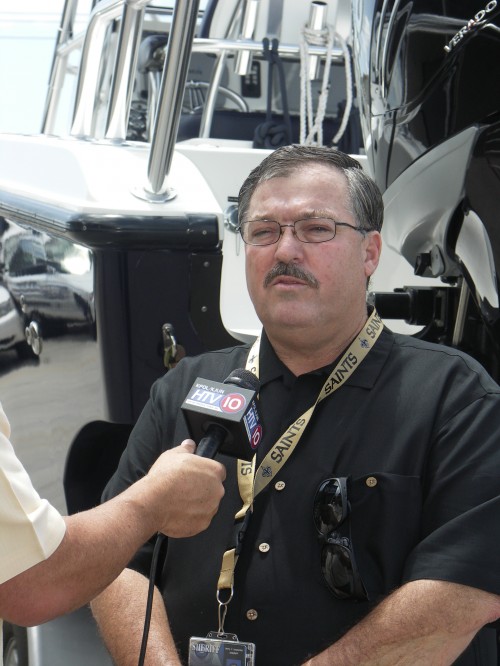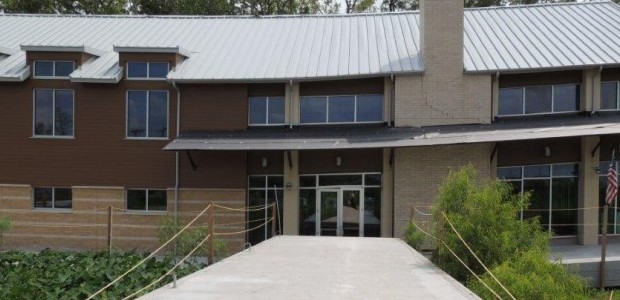
Leola Martin Callahan
July 11, 2012
Sheriff blasts Bourgeois’ spending
July 18, 2012Fixing a sunken welcome center for tourists in Morgan City could include lifting it out of the swamp or using a revolutionary pile-driving mechanism.
Either idea has the same end result – additional pilings are needed to cure the building’s foundation issue.
The nearly complete $3.8 million Cajun Cabin Swamp Attraction was set to open July 15.
But those plans were placed on hold after the building began to sink into the swamp last month. Since beginning its descent June 14, it has sunk a more than five feet and an inch.
The center was built on the other side of the levee, at the Martin Luther King exit just off an elevated portion of U.S. Highway 90. The building is situated at the first exit for motorists who are entering Morgan City from the west.
Carrie Stansbury, director of the St. Mary Parish Tourist Commission, said she still has no answers as to why the building started to sink. She said the Tourist Commission Board of Directors, which does business as the Cajun Coast Tourist Commission, hired Washer Hill Lipscomb Cabanis Architects of Baton Rouge to design the facility, and Laplace-based Aegis Construction Inc. to build it.
Stansbury has repeatedly said the building still belongs to Aegis, and it is insured and bonded.
Recently, Stansbury said her board hired Gary McGoffin, of the firm Durio, McGoffin, Stagg & Ackermann in Lafayette, to represent the Cajun Coast in the unexpected anomaly.
“One way or another, whether the parties involved repair the building or tear it down completely, I feel very confident that we will have a structure ready to move in by sometime next year,” Stansbury said. “Also, I want to say all parties that have been involved in building this project are working together very well, with solutions on how to resolve the problem, instead of going through a long-drawn out litigation process.”
McGoffin said that he has been holding numerous meetings with Washer Hill and Aegis on ideas. He will meet with them again this week, before the Tourist Commission Board meets on July 25. “Frankly, we still don’t know what happened,” he said. “One can say the obvious, that while looking at the structure, it did not have enough pilings, yet we still don’t know if it’s a number, or a problem with the soil underneath.”
The building, 16,000 square feet, appears to have sunken in the middle. Photos taken since the sinking started show water lilies at a level higher than the front door.
“The building does seem to have settled, and is not sinking any further. We began testing that the day it sunk, when two posts were painted an orange color, to measure water land and water levels,” McGoffin said. “On July 5, we met with the contractor, architect, structural and geotechnical engineers involved in the project. It was agreed that the cause and the cure of the foundation issues are integrally related and best explored together.
“The parties are optimistic that the entire structure can be raised and repaired.”
McGoffin said one idea for a repair is to call upon the services of Expert House Movers, a company experienced in large lifts.
“Our plan is take the Welcome Center out of the swamp, examine the area, drill more pilings, and ready the foundation, in order to move it back in place for operation,” McGoffin said.
Expert House Movers, or EHM as they refer to themselves on online (www.experthousemovers.com), are often featured in National Geographic.
The company has video posted on its website of its work.
One big EHM project involved moving the 4,800-ton Cape Hatteras Lighthouse in North Carolina.
In Washington, D.C., last week, the company also moved six historic structures to make room for a new, 11-story building for the Association of American Medical Colleges.
EHM’s website also states that the American Society of Civil Engineers has awarded the company its “Opal” award for outstanding civil engineering.
The company is based in Maryland.
Another idea being discussed would be a project with Boh Bros Construction Company, based in New Orleans.
The proposed plan would involve the company artificially lifting the structure.
“Boh Bros is the best pile-driving company, anywhere,” McGoffin said. “What they’re suggesting is for them to cut a hole in the floor near the area where the building is sinking and drive pilings to provide an additional foundation.
“They actually have a pile driver that they can move into the building, and drive pilings in four-foot sections. As the piling gets close to the floor level, they can weld an additional four feet, in order to drive down to the desired level they want to reach. Now, what’s it all going to cost, and who is going to pay for it? Well, we haven’t got to that point yet.”
McGoffin said regardless of which idea the commission decides to follow through with, one thing is for sure – the building must be sealed and preserved in its present state. He added that’s to prevent humidity, mold and insects, possibly snakes, from entering the building.
“We have to reactivate the building’s [heating, ventilation and air conditioning] system to see if it still works in order to eliminate mold and humidity within the building,” McGoffin said. “Also, although it is not a huge flow, water is entering the building in one area on the first floor. This will be sandbagged.”
Plans for the building, when completed and repaired, include a downstairs welcome area and an interpretive center.
The upstairs will include the administrative offices of the tourist commission.
Also, a balcony around the building will provide visitors a picturesque view of the wetlands and of a swamp.
“This is going to be so much more than a Welcome Center,” Stansbury said. “When we’re done, we’re going to throw events there, especially for local public participation.”
Stansbury said it really is hard to provide a true number of tourists who visit St. Mary Parish on an annual basis because not all visitors stop at the welcome center.
However, she said the results of a recent survey showed that day travelers spent an average of five hours in St. Mary Parish.
“Aside from the Shrimp (and Petroleum) Festival, I’d say conservatively, that there are 30,000 to 50,000 tourists are visiting St. Mary Parish on an annual basis.”
She said the visitors come to St. Mary from other parts of the state and also from Texas, Mississippi, Oklahoma and Florida.
The top two international visitors that sight-see in St. Mary Parish are from France and Canada.
McGoffin said there is no doubt the Cajun Coast will be working in the new center in 2013.
“How deep into 2013? I don’t know. But they will be in there,” he said.
Stansbury still hasn’t released a report on how much the tourist commission has paid thus far in constructing the building.
However, she did say roughly $1.6 million was bonded. “We borrowed money to pay for the welcome center and ‘bonded’ a funding source to pay off the bonds,” she said.
Additional funds were provided by the Department of Natural Resources’ Atchafalaya Basin Program ($300,000 grant); capitol outlay monies, State of Louisiana ($425,000); $1.1 million from local sales tax revenues and $327,572.46 from the Cajun Coast Savings.
St. Mary Parish’s Cajun Cabin Swamp Attraction was days away from opening when, on June 14, it fell just over 5 feet. Sandbags are in place to keep swampwater from seeping into the facility.











